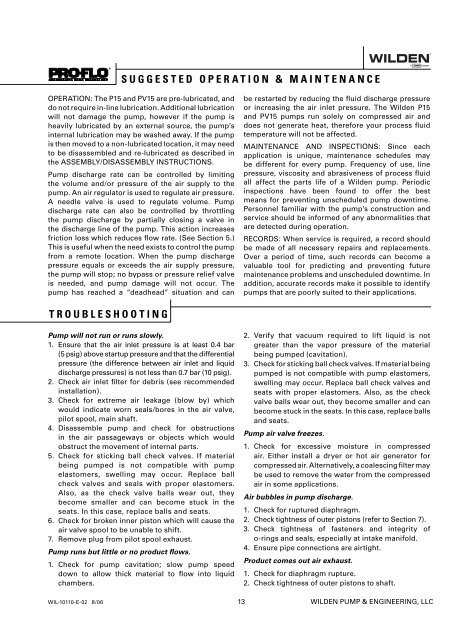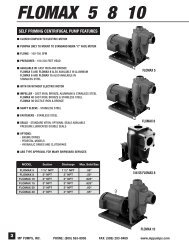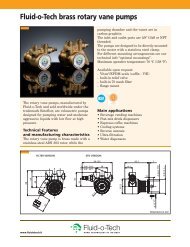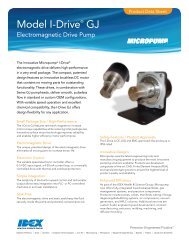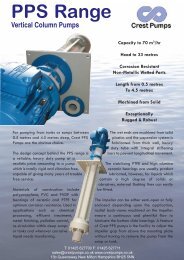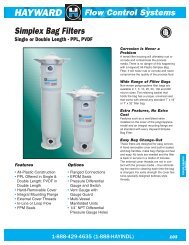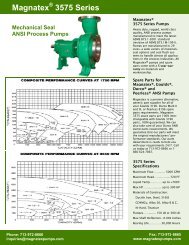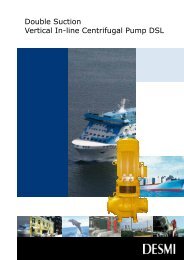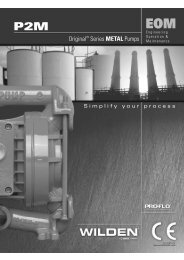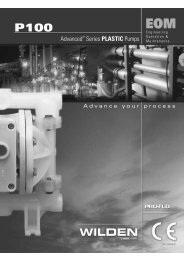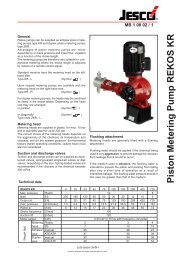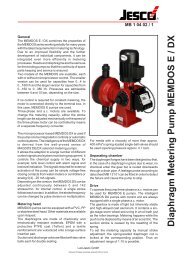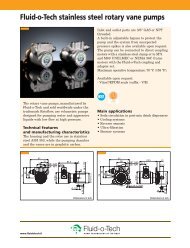P15/PV15 - Process Pumps
P15/PV15 - Process Pumps
P15/PV15 - Process Pumps
- No tags were found...
You also want an ePaper? Increase the reach of your titles
YUMPU automatically turns print PDFs into web optimized ePapers that Google loves.
SUGGESTED OPERATION & MAINTENANCEOPERATION: The <strong>P15</strong> and <strong>PV15</strong> are pre-lubricated, anddo not require in-line lubrication. Additional lubricationwill not damage the pump, however if the pump isheavily lubricated by an external source, the pump’sinternal lubrication may be washed away. If the pumpis then moved to a non-lubricated location, it may needto be disassembled and re-lubricated as described inthe ASSEMBLY/DISASSEMBLY INSTRUCTIONS.Pump discharge rate can be controlled by limitingthe volume and/or pressure of the air supply to thepump. An air regulator is used to regulate air pressure.A needle valve is used to regulate volume. Pumpdischarge rate can also be controlled by throttlingthe pump discharge by partially closing a valve inthe discharge line of the pump. This action increasesfriction loss which reduces flow rate. (See Section 5.)This is useful when the need exists to control the pumpfrom a remote location. When the pump dischargepressure equals or exceeds the air supply pressure,the pump will stop; no bypass or pressure relief valveis needed, and pump damage will not occur. Thepump has reached a “deadhead” situation and canbe restarted by reducing the fluid discharge pressureor increasing the air inlet pressure. The Wilden <strong>P15</strong>and <strong>PV15</strong> pumps run solely on compressed air anddoes not generate heat, therefore your process fluidtemperature will not be affected.MAINTENANCE AND INSPECTIONS: Since eachapplication is unique, maintenance schedules maybe different for every pump. Frequency of use, linepressure, viscosity and abrasiveness of process fluidall affect the parts life of a Wilden pump. Periodicinspections have been found to offer the bestmeans for preventing unscheduled pump downtime.Personnel familiar with the pump’s construction andservice should be informed of any abnormalities thatare detected during operation.RECORDS: When service is required, a record shouldbe made of all necessary repairs and replacements.Over a period of time, such records can become avaluable tool for predicting and preventing futuremaintenance problems and unscheduled downtime. Inaddition, accurate records make it possible to identifypumps that are poorly suited to their applications.TROUBLESHOOTINGPump will not run or runs slowly.1. Ensure that the air inlet pressure is at least 0.4 bar(5 psig) above startup pressure and that the differentialpressure (the difference between air inlet and liquiddischarge pressures) is not less than 0.7 bar (10 psig).2. Check air inlet filter for debris (see recommendedinstallation).3. Check for extreme air leakage (blow by) whichwould indicate worn seals/bores in the air valve,pilot spool, main shaft.4. Disassemble pump and check for obstructionsin the air passageways or objects which wouldobstruct the movement of internal parts.5. Check for sticking ball check valves. If materialbeing pumped is not compatible with pumpelastomers, swelling may occur. Replace ballcheck valves and seals with proper elastomers.Also, as the check valve balls wear out, theybecome smaller and can become stuck in theseats. In this case, replace balls and seats.6. Check for broken inner piston which will cause theair valve spool to be unable to shift.7. Remove plug from pilot spool exhaust.Pump runs but little or no product flows.1. Check for pump cavitation; slow pump speeddown to allow thick material to flow into liquidchambers.2. Verify that vacuum required to lift liquid is notgreater than the vapor pressure of the materialbeing pumped (cavitation).3. Check for sticking ball check valves. If material beingpumped is not compatible with pump elastomers,swelling may occur. Replace ball check valves andseats with proper elastomers. Also, as the checkvalve balls wear out, they become smaller and canbecome stuck in the seats. In this case, replace ballsand seats.Pump air valve freezes.1. Check for excessive moisture in compressedair. Either install a dryer or hot air generator forcompressed air. Alternatively, a coalescing filter maybe used to remove the water from the compressedair in some applications.Air bubbles in pump discharge.1. Check for ruptured diaphragm.2. Check tightness of outer pistons (refer to Section 7).3. Check tightness of fasteners and integrity ofo-rings and seals, especially at intake manifold.4. Ensure pipe connections are airtight.Product comes out air exhaust.1. Check for diaphragm rupture.2. Check tightness of outer pistons to shaft.WIL-10110-E-02 8/06 13 WILDEN PUMP & ENGINEERING, LLC


